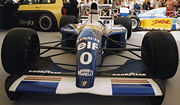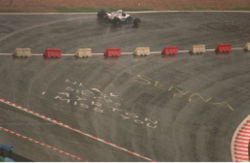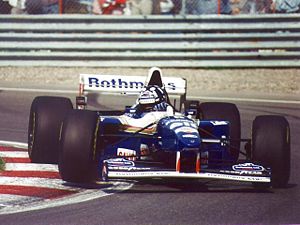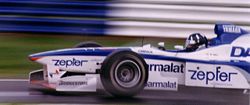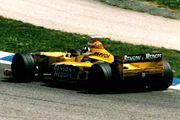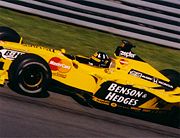Damon Hill
2008/9 Schools Wikipedia Selection. Related subjects: Sports and games people
| Damon Hill | |
|---|---|
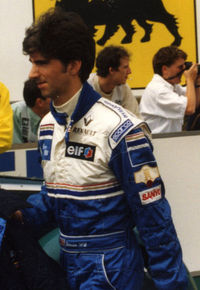 |
|
| Nationality |
|
| Formula One World Championship career | |
| Active years | 1992– 1999 |
| Teams | Brabham, Williams, Arrows, Jordan |
| Races | 122 (115 starts) |
| Championships | 1 ( 1996) |
| Wins | 22 |
| Podium finishes | 42 |
| Career points | 360 |
| Pole positions | 20 |
| Fastest laps | 19 |
| First race | 1992 British Grand Prix |
| First win | 1993 Hungarian Grand Prix |
| Last win | 1998 Belgian Grand Prix |
| Last race | 1999 Japanese Grand Prix |
Damon Graham Devereux Hill OBE (born 17 September 1960 in London) is a British former racing driver from England.
He was the 1996 Formula One World Champion. As the son of the late double Formula One world champion Graham Hill, he is the only son of a world champion to win the title. Despite the famous family name, Hill had an uphill struggle to reach the ranks of F1.
Damon Hill came to professional motorsports relatively late: he began racing motorcycles in 1983 at the age of 23. The following year, he won the 350 cc Clubman's cup at Brands Hatch. In 1985, he moved on to four-wheel single-seater racing with Team Van Diemen in the Formula Ford championship, before moving up into the UK Formula 3 championship in 1986. After three seasons in Formula 3, where he won four races, Hill ascended another tier of open-wheel racing by joining Mooncraft in the International Formula 3000 championship, where, although often competitive, he never won a race.
Hill started his Formula One career in 1992 with the then uncompetitive Brabham team. His debut race was at the British Grand Prix where he qualified on the back row. He took the first of his 22 victories at the 1993 Hungarian Grand Prix for the Williams team the following year. In 1994, he won the British Grand Prix, a race his father had never won in his long and successful career. During the mid 1990s, Hill was Michael Schumacher's main rival for the Formula One Driver's Championship, finishing runner-up in the German's 1994 and 1995 title seasons. The two had a series of controversial clashes on and off the track, including the collision at the 1994 Australian Grand Prix that gave Schumacher his first title by a single point. Hill took eight victories and the world championship in 1996. Despite this, Williams decided in mid-1996 not to renew Hill's contract for 1997. He went on to record the Jordan team's first ever win at the 1998 Belgian Grand Prix, and came within a few miles of being the only driver to win a Grand Prix for the Arrows team and their Yamaha engine supplier at the 1997 Hungarian Grand Prix. He retired from the sport at the end of the 1999 season, after 122 races.
In 2006, Hill became president of the British Racing Drivers' Club, succeeding Jackie Stewart.
Personal and early life
Hill was born in Hampstead on 17 September 1960 to double Formula One world champion Graham Hill, who won his first World Championship two years after Damon's birth, and his wife Bette. Hill has two sisters, Samantha and Brigitte. Brigitte was an actress; she starred in her first film (Caravan to Vaccares) in 1974, and started Hill Marketing in 1998 after working with Damon. In 2002, she began managing the unrelated American racing driver Derek Hill, son of 1961 Formula One World Champion Phil Hill.
While in his teens Damon attended the prestigious Haberdashers' Aske's Boys' School in Hertfordshire. The death of his father, and upcoming driver Tony Brise and four other mechanics, in a plane crash in 1975 when Damon was only 15 years old left the Hill family in drastically changed circumstances; Hill worked as a labourer and a motorcycle courier to support his further education.
Damon is married to Georgie (born 29 April 1961) and they have four children: Oliver (born 4 May 1989), Joshua (born 9 January 1991), Tabitha (born 16 July 1995) and Rosie (born 1 February 1998). Oliver was born with Down's syndrome and Damon and Georgie are both active supporters of related charities.
Career
Pre-Formula One
Hill started his motorsport career in motorcycle racing in 1983, winning the 350 cc clubman's championship at Brands Hatch, before taking a race car course at the Winfield Racing School in France. Hill did not make his single-seater debut until 1984, wearing the blue and white colours of the London Rowing Club on his helmet as his father had done. He slowly graduated through Formula Ford, winning six races for Team Van Diemen in 1985. Hill then moved up into Formula Three where he raced for three different teams in three years, with a steady first season for Mooncraft in 1986 and brace of wins in each of the following years for Middlebridge Racing and then Intersport. In 1989 Hill progressed to Formula 3000, racing again for Mooncraft and then Middlebridge Racing over the next three years. Although Hill ran at the front with the unfavoured Lola chassis for Middlebridge in 1990 and 1991 - he took three pole positions and led five races in 1990 - he did not win a race during his Formula 3000 career.
Formula One
1992: Brabham
Related Article: Brabham
Initially, Hill started his Grand Prix career with the Williams team as a test driver during the 1991 season, still competing in the F3000 series. However, mid–way through 1992 Hill broke into the Grand Prix racing as a driver with the struggling Brabham team in 1992. The former championship-winning team was in serious financial difficulties. Hill only started the season after three races, replacing Giovanna Amati after her sponsorship had failed to materialise. Amati had not been able to get the car through qualifying but Hill matched his team-mate, Eric van de Poele by qualifying for two mid-season Grands Prix: The British Grand Prix and the Hungarian Grand Prix. The Hungaroring would later be the scene of two victories for Hill and he would never again finish out of the points there. Hill was also the test driver for the dominant Williams- Renault team that year.
1993–1996: Williams
Related Article: WilliamsF1
1993
When Nigel Mansell left Williams to drive in CART in 1993, Hill was promoted to the race team alongside Alain Prost ahead of more experienced candidates such as Martin Brundle and Mika Häkkinen. Hill took what was offered from Frank Williams, reportedly $500,000 USD for one season. In his first full season Hill benefited greatly from the vast experience of his veteran French team-mate. At the Brazilian and European grands prix, he drove well enough in wet weather to finish second, while Prost fared poorly in the rain. Hill took pole at the French GP and closely followed Prost, team orders preventing him from seriously challenging for the win. He suffered four retirements in the first half of the season, including an engine failure at Silverstone while leading, and a puncture near the end of the German Grand Prix while leading again. After that, the Englishman went on to win three successive races in Hungary, Belgium and Italy. In doing so he became the first son of a Formula One Grand Prix winner to take victory himself. Hill's third consecutive win clinched the constructors' championship for Williams and moved him temporarily to second in the driver's standings until McLaren's Ayrton Senna passed him by winning the last two races. Prost finished the season as champion.
Traditionally the reigning driver's world champion carries the number '1' on his car; his team-mate takes the number '2'. As Nigel Mansell, the 1992 champion, was not racing in Formula One in 1993, his Williams team were given numbers '0' and '2'. As the junior partner, Hill took '0', the second man in Formula One history to do so, after Jody Scheckter in 1973. As a result of the major difference in build between Hill and Prost, the Frenchman being a foot shorter, Williams eventually opted to build two slightly different FW15C tubs. This was also to accommodate Hill's size 12 feet, as he had repeatedly complained of cramp in the tight confines around the pedals.
1994
In 1994 the triple world champion Ayrton Senna joined Hill at Williams. As the reigning champion - this time Prost - was again no longer racing, Hill retained his number '0'. The pre-season betting had been that Senna would coast to the title, but with the banning of electronic driver aids, Benetton and Schumacher initially proved more competitive and took the first three races.
At Imola, Ayrton Senna died after his car went off the road at Tamburello, and with the team undergoing investigation from the Italian authorities on manslaughter charges, Hill found himself team leader with only one season’s experience in the top flight. It was widely reported at the time that the car's steering column had failed, though Hill told BBC Sport in 2004 that he believed Senna simply took the corner too fast for the conditions - refering to the fact that the car had just restarted the race with cold tyres after being held by a safety car. .
Monaco was the next race where Hill represented Williams alone, however luck was not with him and his race ended early.
Test driver David Coulthard was promoted to replace Senna. Under difficult circumstances Hill took an emotional win at Barcelona, four weeks after Senna's death, much as his father had done 26 years earlier for Lotus after the death of his team mate Jim Clark. Schumacher struggled home in second with a gearbox fault, having comfortably led the early laps. With four races left, Frank Williams brought back 1992 champion Nigel Mansell to replace Coulthard. Mansell would get approximately £900,000 per race, while Hill was paid £300,000 for the entire season, though Hill's position as lead driver remained unquestioned.
Although Schumacher dominated the early part of the season, leading 66 points to 29, Hill came back into contention for the title after winning the British Grand Prix, a race in which his late father had never tasted victory. Schumacher was disqualified from that race and banned for two further races for overtaking during the formation lap and ignoring a black flag. Four more victories for Hill, three of which were in races where Schumacher was banned or disqualified, took the title battle to the final event at Adelaide. At Schumacher's first race since his ban, the European GP, he suggested that Hill (who was eight years Schumacher's senior) was not a world class driver. However, during the penultimate race at Suzuka, Hill took victory in a rain-soaked restart over Schumacher, putting Hill just one point behind the German.
Neither he nor Schumacher finished the final race, in Adelaide, after a controversial collision which gave the title to Schumacher. Schumacher ran off the track while leading. It is unknown whether Schumacher did or did not damage his Benetton. Hill had just come through the fifth corner of the track when he saw Schumacher returning to the racing line. Coming into the sixth corner Hill moved to the inside to pass the slower moving car and the two collided, breaking the Williams' front left suspension wishbone, and forcing Hill's retirement from the race. BBC Formula One commentator Murray Walker, a great fan and friend of Damon, has often maintained that Schumacher did not cause the crash intentionally. WilliamsF1 co-owner Patrick Head felt differently: After Schumacher's punishment for blocking the circuit during qualifying for the 2006 Monaco Grand Prix, he told F1 Racing that in 1994 "Williams were already 100% certain that Michael was guilty of foul play", but did not protest Schumacher's title because the team was still dealing with the death of Ayrton Senna. Schumacher has been blamed by the UK public for the incident - in 2003, the BBC conducted a search for "The Most Unsporting Moment" in which the Adelaide incident was nominated. Hill himself has recently explicitly accused Schumacher of causing the collision deliberately. (Schumacher would be disqualified from the 1997 championship for causing a similar title-deciding collision with Jacques Villeneuve in the final race.)
Hill's 1994 season earned him the 1994 BBC Sports Personality of the Year.
1995
Coming into the 1995 season, Hill was confident of title glory. The Williams team were reigning constructors champions, having beaten Benetton in 1994, and with young David Coulthard, who was embarking on his second season in Formula One, as team-mate, Hill was undoubtedly the number one driver. The season started badly when he spun off in Brazil due to a mechanical problem, but a couple of wins put him in the championship lead. It was not to last. Schumacher hit top form and successfully defended his title with two races to spare, while Benetton took the constructors championship. Hill made several high profile errors in 1995, most notable in Britain and Italy. At the final race in Adelaide, Hill had one of the most dominant victories in the history of F1, finishing two laps ahead of the runner-up.
As 1995 was a disappointing season for Hill, Frank Williams began to consider bringing in Heinz-Harald Frentzen for the future. At least some of the Williams team had been upset with Hill's performances. With Hill already under contract for 1996 his place at the team was secure for one more season, but it would prove to be his last at the Grove squad.
1996
In 1996 the Williams car was clearly the quickest in Formula One and Hill went on to win the title ahead of rookie teammate Jacques Villeneuve, becoming the first and only son of a Formula One champion to win the championship himself. Taking eight wins and never qualifying off the front row, Hill enjoyed by far his best season. At Monaco, the legendary circuit where his father had been so dominant, he had been on course for victory until his engine blew, curtailing his race and allowing Ligier driver Olivier Panis to take his one and only win. Near the end of the season, Villeneuve began to mount a title challenge and took pole in the final race at Suzuka; however Hill reasserted his dominance at the start and took the victory while the Canadian retired. Hill celebrated his title win on the podium, alongside runner-ups Schumacher, now at Ferrari, and Mika Häkkinen of McLaren.
Despite winning the title, Hill learned before the season's close that he was to be dropped by Williams in favour of Frentzen for the following season, to the outrage of his fans. (Frentzen, however, would only manage one victory with the team.) Hill left Williams as the team's second most successful driver, in terms of race victories, with 21, second only to Nigel Mansell.
Hill's 1996 world championship earned him his second BBC Sports Personality Of The Year Award, making him one of only three people ever to receive the award twice – the others being Boxer Henry Cooper and fellow Formula One driver Nigel Mansell. Hill was also awarded the Segrave Trophy by the Royal Automobile Club. The trophy is awarded to the British national who accomplishes the most outstanding demonstration of the possibilities of transport by land, sea, air, or water.
1997: Arrows
Related Article: Arrows
As world champion Hill was in high demand, and had offers to drive from both McLaren and Ferrari. However, in Hill's opinion neither fully valued his World Champion status. Instead, he surprisingly signed to Arrows, a team which had never won a race in its 20 year history and had scored only a single point the previous year. His title defence in 1997 proved unsuccessful, getting off to a poor start when he only narrowly managed to qualify for the Australian Grand Prix, and then retired on the parade lap. The Arrows car, using tyres from series debutant Bridgestone and engines from unfancied Yamaha, was generally uncompetitive, and Hill did not score his first point for the team until the British Grand Prix at Silverstone in July. The highlight of the year came at the Hungarian Grand Prix. On a day when the Bridgestone tyres had a competitive edge over their Goodyear rivals, Hill qualified third in a car which had not previously placed higher than 9th on the grid. During the race he managed to pass championship contender and old rival Michael Schumacher on the track and was leading, well ahead of the eventual 1997 World Champion Villeneuve, late in the race when a hydraulic problem slowed the Arrows drastically. This allowed Villeneuve to pass him and win, although Hill still salvaged second place and the team's first podium since the 1995 Australian Grand Prix.
1998–1999: Jordan
Related Article: Jordan Grand Prix
1998
Despite the result in Hungary, it was clear that Arrows could not provide Hill with the kind of success that he was used to. For 1998 he switched to Jordan to partner Ralf Schumacher, the younger brother of Michael Schumacher. The first half of the season was disastrous, with the car off the pace and unreliable. In Canada however, things began to improve. Hill benefited from others' misfortunes to lead the race and enjoyed a high speed duel with arch rival Michael Schumacher. He did not finish in Montreal, but had shown his speed once more. Finally at Hockenheim he scored his first point of 1998. At Spa he took Jordan's first ever win, leading home his team-mate for a 1-2 in soaking conditions, in an incredibly dramatic race which only eight drivers finished. It was his first victory since being dropped by Williams, whose duo of Villeneuve and Frentzen won no races that season. He went on to finish the year very strongly with a last lap move on Frentzen at Suzuka which earned him 4th place in the race, and Jordan 4th in the constructors championship.
1999
Hopes were high for 1999, but Hill did not enjoy a good season. Struggling with the new four-grooved tyres introduced that year, he was outpaced by his new team-mate - none other than his replacement at Williams, Heinz-Harald Frentzen - and appeared to lose motivation. After an inglorious crash at Montreal he announced plans to retire at the end of the year, but after a miserable French Grand Prix, which Frentzen won, he considered quitting immediately.
Jordan persuaded Hill to stay on for Silverstone. Going into the weekend, Hill was talking of stopping after the race, so Jordan had tested Jos Verstappen as a contingency for Hill retiring mid-season. Following a strong fifth place at his home event, Hill opted to see out the year. Two more points were added that year with a sixth place at Spa, the scene of his last win, representing his final top-six finish in Formula One. Meanwhile, team-mate Frentzen was a title contender going into the final few races, and eventually finished third in the championship. Hill and Frentzen would help Jordan to its best-ever finish of third in the constructors' championship.
With three races of 1999 to go, there were rumours that Prost would release Jarno Trulli, who had signed for Jordan for 2000, early to replace Hill, but the Briton completed the season. At Suzuka his last race in Formula One ended when he spun off the track and pulled into the pits to retire a healthy car.
Notable battles with Michael Schumacher
Hill and Michael Schumacher clashed frequently on the track in the mid 1990s:
- Spa 1994: The two made contact at the Les Combes corner. On this occasion Schumacher received a one-race suspended ban, although not for this reason, it was actually for a plank wear infringement.
- Japan 1994: Schumacher led the early stages of the rain-soaked event only for the race to be stopped after Brundle's McLaren crashed. Hill took over the lead at the re-start and pushed very hard to beat Schumacher, the acknowledged ‘rain master’, in the wet and take the title fight to the final race of the season in Australia.
- Adelaide 1994: Schumacher went off the track while leading the last race of the season. He returned to the track at reduced speed where Hill tried to pass him at the next corner. The two collided and both retired. Schumacher retained his one point lead to take the world championship.
- Silverstone 1995: At his home grand prix and trailing Schumacher by 11 points in the championship, Hill attempted to pass the German going into Priory 11 laps from the end of the race. The two collided again and both retired. Hill described it as a "racing incident" while Schumacher compared it to Adelaide 1994.
- Spa 1995: Schumacher was forced to start the race from 16th place after a crash in qualifying, Hill started in 8th, but by lap 17 Schumacher was in the lead with Hill closing fast in slippery conditions. Hill had the right tyres fitted and was looking for a way past the German for a number of laps. Schumacher repeatedly blocked and squeezed Hill, until he made a mistake and slid off the track. Schumacher went on to win with Hill second. Schumacher's tactics earned him a one race suspended ban.
- Monza 1995: On lap 24 Hill and Schumacher collided when trying to lap Taki Inoue. Neither accepted blame. Hill questioned why Schumacher was "suddenly doing nought miles an hour", while many described it as a "reckless move" by Hill. Hill received a suspended one-race ban, which was never put into effect.
- Nurburgring 1995: On lap 18 Hill attempted to overtake Schumacher but the German blocked and squeezed him to the edge of the track. Hill locked up and hit the back of the Benetton.
- Hungary 1997: After qualifying third in the usually uncompetitive Arrows, Hill passed Schumacher cleanly on the inside on lap 11 going into the first corner before pulling away into the lead of the race.
- Canada 1998: Schumacher accused Hill of "dangerously weaving" while they were dicing for second. Hill responded by saying that Schumacher's comments were "rich" coming from someone who forced Heinz-Harald Frentzen off the track in the very same race.
Helmet
Damon Hill uses the same helmet design as his father, a simple, easily identifiable design of eight white oar blades arranged vertically around the upper surface of the helmet, which is dark blue. The device and colours represent the London Rowing Club of which Graham and Bette Hill were both successful members and where they first met. Although Hill is not a rower himself, he has said that he is proud to wear his father's colours and the club are happy for him to keep up the tradition.
The sponsors on Damon's helmet have been AGV (Helmet Manufacturer), Cellnet, Ricoh, Arai (Helmet Manufacturer), Camel, Olympus, Elf, Renault, Canon, Sega, Rothmans, Andersen Consulting, Danka, PlayStation, Remus, Delphi, Benson & Hedges and Hill Sport.
Later life
In retirement Hill, together with Michael Breen, founded and set up the Prestige and Super Car Private Members Club P1 International, based in Leatherhead, Surrey, England. He is no longer associated with P1 International. He also became involved in a BMW dealership that bore his name plus an Audi dealership in Exeter. He has contributed many articles to the world's best-selling grand prix magazine, F1 Racing. Hill has raced both cars and motorcycles at the Goodwood Festival of Speed and in 2005 he tested the new GP2 car, lapping impressively from the off.
Breen bought Hill out in October 2006, and Hill then moved on to become President of the BRDC (British Racing Drivers Club), succeeding Sir Jackie Stewart.
Hill also did a famous UK television advert with Murray Walker for Pizza Hut's stuffed-crust pizza, in which Walker commentated on Hill's meal as if it were a race. Parodying Hill's 1994 and 1995 seasons, the advert sees Walker jokingly report that "... Hill finishes second... again!” before being threatened by Hill and replying (in his famous commentary tones) "He's lost it! He's out of control!"
Hill appeared in the 2005 series of the British automotive programme Top Gear in the UK in June, where he set a time of 1:46.3 around their test course. This was the fastest time recorded at that point, although the record has since been broken by fellow former British Formula One driver, Nigel Mansell with a time of 1:44.6 (for the F1 lap times), Jenson Button with a time of 1:44.7, Lewis Hamilton with a time of 1:44.7 (in the wet) and the show's 'tame racing driver', The Stig with a time of 1:44.4 (for both F1 and Star boards). During the show, presenter Jeremy Clarkson joked about claims that Hill was in fact The Stig (the programme's anonymous benchmark test driver), by smelling his breath and after a slight pause replying to the audience, "Yep...Magnesium", implicitly identifying him as the Stig through an apparent shared attribute. Hill himself stresses that he is not the Stig, but many continue to believe the claims.
As well as his Top Gear appearance, Hill appeared in a number of other TV shows, appearing in an episode of This is Your Life and before taking part in the 1998 French Grand Prix, Hill appeared as a guest on TFI Friday. Hill later appeared on other shows, such as Shooting Stars; Late Show with David Letterman; Clive Anderson All Talk and appeared as a guest star on the first episode of Bang Bang, It's Reeves and Mortimer. When Jason Statham required stunt driving lessons for his role as Handsome Rob in the 2003 remake of The Italian Job, he asked Hill to help him out.
In April 2006, Hill succeeded Jackie Stewart as President of the BRDC ( British Racing Drivers' Club). The BRDC, owner of the Silverstone circuit, is at a crucial stage as it seeks to steer the future of the track and its facilities while facing increased competition from newer international facilities domestically and abroad. In June of the same year Hill defended Britain's current next hope for the Formula One title, Jenson Button in the media, claiming that Button was being held back by his Honda car rather than his own driving ability.
Hill was back behind the wheel of a single-seater race car in the summer of 2006, when he took a 600 bhp (450 kW) Grand Prix Masters machine for a test run around Silverstone. In an interview with ITV F1, Hill said that he enjoyed the experience and that he might consider racing in the GP Masters in the future. He was also asked in the interview to give his opinion on Jenson Button's maiden Grand Prix victory in Hungary, saying that he thought Jenson was "good" and that he was "a very fast driver." He was also asked in the interview about the battle between his old rival, Michael Schumacher and Fernando Alonso, Hill said that he was "just as fascinated as anyone to see what’s going to happen".
Hill made a one-off appearance in ITV F1's commentary box, covering for Martin Brundle at the 2007 Hungarian Grand Prix. Commenting on the qualifying controversy that affected McLaren Mercedes drivers Lewis Hamilton and Fernando Alonso, Hill jokingly suggested the FIA brought in a naughty chair to the sport to prevent drivers misbehaving unsportingly on track, the technique used by 'supernanny' Jo Frost.
Music career
Damon Hill formed the punk band "Sex, Hitler and the Hormones" with some friends while at school. Hill once joked in an interview that at that time they did not go on tour because they did not have mopeds. Hill continued to be interested in music and after achieving success in Formula One became friends with ex-Beatle George Harrison, with whom he played several times. Hill also recorded with rock band Def Leppard after meeting their lead singer Joe Elliott at a party. He played on the opening track of the album Euphoria, "Demolition Man", including a 10-second guitar solo. Elliott described Damon's style as "a cross between the way Slash plays and Andy McCoy from Hanoi Rocks".
During his racing career Hill often played in front of a crowd of Formula One fans at the British Grand Prix at Silverstone. In 1999 Hill's team boss at the time, Eddie Jordan, starred on drums while he played for his fans for the very last time at Silverstone. Hill has also played with the S.A.S. band, which has many guest performances, and with Pat Cash's Wild Colonial Boys.
Hill's most recent band was The Conrods which was active up to 2003. The band was formed after his retirement from racing at the end of the 1999 season and played cover versions of well known songs from The Rolling Stones, Beatles and Kinks. Band members were Damon Hill (guitar), Josh Phillips (keyboards; Midge Ure & Whitesnake), Mark Brzezicki (drums; Big Country), Steve Brzezicki (bass; Scatman John), Robert Hart (vocals; Bad Company) and Steve Roux (guitar/vocals). The band performed at Grands Prix, Formula One social events and in various smaller venues as well as on several TV programmes. Since becoming president of the BRDC Hill claims to have abandoned the guitar - being "too busy doing school runs and looking after pets."
Complete Formula One results
( key) (Races in bold indicate pole position)
| Year | Entrant | Chassis | Engine | 1 | 2 | 3 | 4 | 5 | 6 | 7 | 8 | 9 | 10 | 11 | 12 | 13 | 14 | 15 | 16 | 17 | WDC | Points |
|---|---|---|---|---|---|---|---|---|---|---|---|---|---|---|---|---|---|---|---|---|---|---|
| 1992 | Motor Racing Developments Ltd. |
Brabham BT60B | Judd | RSA |
MEX |
BRA |
ESP DNQ |
SMR DNQ |
MON DNQ |
CAN DNQ |
FRA DNQ |
GBR 16 |
GER DNQ |
HUN 11 |
BEL |
ITA |
POR |
JPN |
AUS |
30th | 0 | |
| 1993 | Canon Williams Team | Williams FW15C | Renault | RSA Ret |
BRA 2 |
EUR 2 |
SMR Ret |
ESP Ret |
MON 2 |
CAN 3 |
FRA 2 |
GBR Ret |
GER 15 |
HUN 1 |
BEL 1 |
ITA 1 |
POR 3 |
JPN 4 |
AUS 3 |
3rd | 69 | |
| 1994 | Rothmans Williams Renault | Williams FW16 | Renault | BRA 2 |
PAC Ret |
SMR 6 |
MON Ret |
ESP 1 |
CAN 2 |
FRA 2 |
GBR 1 |
GER 8 |
HUN 2 |
BEL 1 |
ITA 1 |
POR 1 |
EUR 2 |
JPN 1 |
AUS Ret |
2nd | 91 | |
| 1995 | Rothmans Williams Renault | Williams FW17 | Renault | BRA Ret |
ARG 1 |
SMR 1 |
ESP 4 |
MON 2 |
CAN Ret |
FRA 2 |
GBR Ret |
GER Ret |
HUN 1 |
BEL 2 |
ITA Ret |
POR 3 |
EUR Ret |
PAC 3 |
JPN Ret |
AUS 1 |
2nd | 69 |
| 1996 | Rothmans Williams Renault | Williams FW18 | Renault | AUS 1 |
BRA 1 |
ARG 1 |
EUR 4 |
SMR 1 |
MON Ret |
ESP Ret |
CAN 1 |
FRA 1 |
GBR Ret |
GER 1 |
HUN 2 |
BEL 5 |
ITA Ret |
POR 2 |
JPN 1 |
1st | 97 | |
| 1997 | Danka Arrows Yamaha | Arrows A18 | Yamaha | AUS DNS |
BRA Ret |
ARG Ret |
SMR Ret |
MON Ret |
ESP Ret |
CAN 9 |
FRA 12 |
GBR 6 |
GER 8 |
HUN 2 |
BEL 13 |
ITA Ret |
AUT 7 |
LUX 8 |
JPN 11 |
EUR Ret |
12th | 7 |
| 1998 | B&H Total Jordan | Jordan 198 | Mugen– Honda | AUS 8 |
BRA DSQ |
ARG 8 |
SMR 10 |
ESP Ret |
MON 8 |
CAN Ret |
FRA Ret |
GBR Ret |
AUT 7 |
GER 4 |
HUN 4 |
BEL 1 |
ITA 6 |
LUX 9 |
JPN 4 |
6th | 20 | |
| 1999 | B&H Jordan | Jordan 199 | Mugen– Honda | AUS Ret |
BRA Ret |
SMR 4 |
MON Ret |
ESP 7 |
CAN Ret |
FRA Ret |
GBR 5 |
AUT 8 |
GER Ret |
HUN 6 |
BEL 6 |
ITA 10 |
EUR Ret |
MAL Ret |
JPN Ret |
12th | 7 |
| Sporting positions | ||
|---|---|---|
| Preceded by Michael Schumacher |
Formula One World Champion 1996 |
Succeeded by Jacques Villeneuve |
| Preceded by Jackie Stewart |
BRDC President 2006 — present |
Incumbent |
| Awards | ||
| Preceded by Nigel Mansell |
Hawthorn Memorial Trophy 1993–1996 |
Succeeded by Jacques Villeneuve |
| Preceded by Linford Christie |
BBC Sports Personality of the Year 1994 |
Succeeded by Jonathan Edwards |
| Preceded by Jonathan Edwards |
BBC Sports Personality of the Year 1996 |
Succeeded by Greg Rusedski |
| Preceded by Derek Warwick |
Autosport British Competition Driver 1993 |
Succeeded by David Coulthard |
| Preceded by Nigel Mansell |
Autosport International Racing Driver Award 1994 |
Succeeded by Michael Schumacher |
| Preceded by David Coulthard |
Autosport British Competition Driver 1995-1996 |
Succeeded by Mark Blundell |
| Preceded by Michael Schumacher |
Autosport International Racing Driver Award 1996 |
Succeeded by Jacques Villeneuve |
